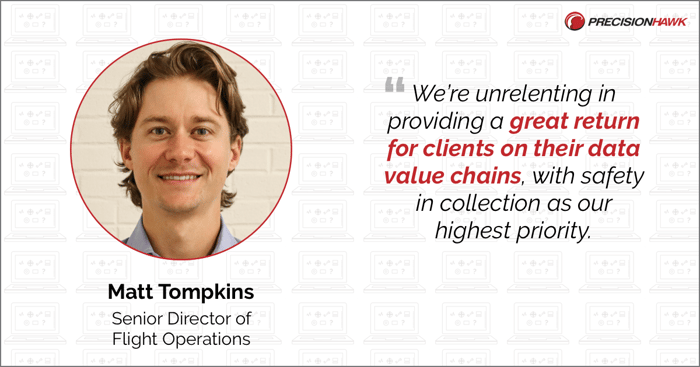Innovation is in our roots—we’ve pioneered best practices in flight operations and geospatial data analysis since our founding in 2010. While we’re experts in blending multiple layers of data sources—our solutions aren’t driven solely by technology. They’re driven by the people of PrecisionHawk.
Today, we spotlight a highly experienced remote pilot with a passion for unmanned aircraft systems policy across the globe—Senior Director of Flight Operations Matt Tompkins.

Career Progression—From Hobby Flying to Career in Flight Operations
“My interest in flight operations really started as a challenging activity to help me keep my brain engaged and learning,” says Matt. “First, I learned to fly drones, and then I learned to build multi-rotor drones and use flight planning software, just flying for fun.”
The potential of flying drones was always clear to Matt, yet it wasn’t until a pivotal moment when watching a TEDx talk that he knew he would pursue a career in the drone industry.
“I understood opportunities were going to emerge, so I turned an interest into a hobby,” says Matt. “Later, I transformed my hobby into a career path, once I understood the potential of the applications of drone technology from a remote-sensing perspective.”
He earned his Bachelor’s Degree in Unmanned Aeronautical Science and launched his career in drone-based aviation while developing the framework and curriculum for a certificate program, pioneering the institution’s investment in the academic program. Matt also earned a private pilot certificate and remote pilot certificate.
“As I focused my time and energy on the emerging technology of drones and their hardware, I realized that there wasn’t yet a comprehensive or systematic approach to regulating drone operations,” says Matt. “I came to believe there would be an opportunity to work with pilots to harness the data gathered from drone missions.”
While leading a flight operations team in collaboration with PrecisionHawk, Matt successfully gathered LiDAR data—data that accurately detects the range, or distance, from the source to the surface of the earth—yielding actionable analysis for the client. Later, when Matt joined the PrecisionHawk team full-time, one of his first accomplishments was expanding PrecisionHawk’s LiDAR capabilities to add value for clients.
“We’re unrelenting in providing a great return for clients on their data value chains, with safety in collection as our highest priority."
- MATT TOMPKINS, SENIOR DIRECTOR OF FLIGHT OPERATIONS
“PrecisionHawk attracts a ton of great, wonderful, and really smart people,” says Matt. “It made sense to join the company because I knew that I would be joining an innovator in the field while adding value for clients across multiple industries.”
Ever since joining, he’s focused his team on developing standard operating procedures for flight operations and a distributed, responsive pilot network capable of responding in real-time to gather a variety of remote-sensing data.
“Regardless of collection method or remote-sensing technology, we’re unrelenting in providing a great return for clients on their data value chains, with safety in collection as our highest priority,” says Matt.
Efficient Flight Operations Enhances Effectiveness
“Early on, we set up flight operations to collect a lot of information, then provided that information to our clients,” says Matt. “In retrospect, many of those early clients likely weren’t prepared to process and use the volume of data that we were able to provide.”
Effective flight operations requires a thorough understanding of a client’s needs, and a structured system that preserves safety, enhances efficiency, and delivers high-quality data that can be immediately analyzed to make important decisions.
“We’re locked in on how we’re able to provide a great return for clients on their data value chain."
- MATT TOMPKINS, SENIOR DIRECTOR OF FLIGHT OPERATIONS
For a leading clean energy company, Matt’s team gathered LiDAR data that allowed the firm to assess specific site locations to determine whether the property would be viable for the construction of a solar array.
After the company identified the most viable site locations and began construction, Matt and his team supported the firm by flying a standard route every day to gather RGB imagery that is immediately processed in an artificial intelligence-powered application that counts the installed equipment.
“Before we put this system in place, gathering this information was a very labor-intensive process, which made for a very long day for an employee,” says Matt. “We turned that long, labor-intensive day into a 20-minute flight, helping our client better scale their efforts to deploy clean energy because they’ve reallocated their employee’s time to work on projects of scale rather than the day-to-day data collection.”
“From a corporate perspective, the successful implementation of a drone-based data collection program is a resource efficiency question—how to deploy their financial resources and their human capital to best address areas of need or opportunity,” says Matt. “And from the human-side, this program allows an individual employee to gain access to a reliable, high-quality, searchable tool that enables them to more effectively and efficiently do their job, freeing them up to address other areas of opportunity.”
Bigger, More Capable Systems—Increasing Demand in 2021
Across industries, there’s an emerging trend that is improving autonomy in drone-based data collection—the implementation of bigger, more capable systems.
“Demand will continue to increase as organizations enhance their ability to use data systems to identify and solve pressing challenges,” says Matt. “Our trained, skilled pilots are advancing our clients’ ability to make important decisions by collecting data using enhanced sensors and industry-leading hardware that results in a faster, smarter analysis of the results.”

Companies that choose to invest in scaling sustainable systems for data collection and analysis will bolster their competitive advantage by harnessing the power of their own data, he says.
“That’s how we operate—we’re locked in on how we’re able to provide a great return for clients on their data value chain,” says Matt.
Matt and his team take a customer-focused approach to resource allocation—and the result is high-quality data, gathered efficiently. That’s because the team is agile, he says.
“We’re highly mobile, and our operations are not constrained to specific regions. That means that we have incredible response rates and that we can be mobile in a matter of hours to gather accurate information,” says Matt. “We scale easily, so as projects emerge or expand, we’re able to respond and scale with our clients, and to do so in a cost-effective manner.”



